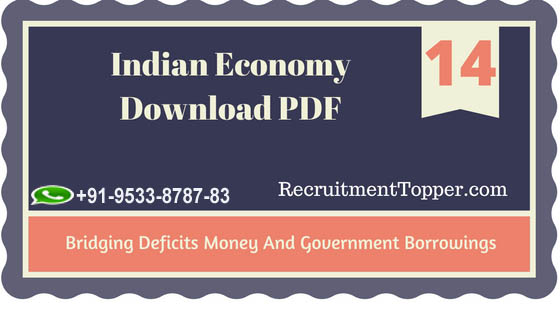Indian Economy | Bridging Deficits Money And Government Borrowings Download PDF
Contents
Reserve Bank of India
In the previous section on government finances, we had discussed about various kinds of deficits. How are deficits met or do they remain as deficits on paper only. Any deficit has to be met. A government budget could be met through either printing of notes or it could be borrowed known as market borrowings of the government.
The fulfilling of deficits takes us into the realms of ‘banking’. At the apex is Reserve Bank of India (RBI) aslo known as the Central Bank of India, which controls banking in India and is also the banker to the government. Both printing of money as well as market borrowings are the major functions of RBI.
But then what is money? Something which has universal acceptability, functions as a medium of exchange, store of value and also having the backing of the government as a legal tender in the economy. Then what is ‘near’ money? Near money functions similar to the money but is not actually money as it is not universally acceptable such as credit cards (also known as plastic money), drafts and debit cards.
Money in India comprises of currency notes of ? 1000, 500, 100, 50,20 and 10 signed by the Governor of RBI and coins of Rs. 10, 5, 2, 1, 50 and 25 paisa which are not signed but carry the denomination and the national emblem.
All notes are printed at the printing presses functioning under the RBI and coins minted at government mints under the Ministry of Finance, Government of India. The basis of printing is minimum reserve system with a minimum value of government-held gold of?200 crores and the remaining is backed by the government securities issued and held by RBI. The RBI/government has complete flexibility in printing of notes. However, printing of money increases the stock of money in relation to goods available and thus pushes up the prices resulting in inflationary pressures.
If the deficit is financed through printing of money it is known as monetization of deficit or monetized deficit. Any monetized deficit will leads to inflation. Realizing the dangers of monetization, governments have switched to market borrowings for meeting the deficit to prevent build-up of inflationary pressures for the past several decades.
What are market borrowings? Market borrowing for meeting the deficit is performed by the RBI, on behalf of the government being a banker to the government. This is performed through issuance of central government securities by RBI and could either treasury bills (borrowings of less than a year) or dated securities (more than a year).
All carry a fixed interest rate (also known as coupon) directly in case of dated securities and can be derived in case of treasury bills. There is always a market for government securities as they are risk-free (gilt edged) as the government can never be a defaulter in meeting its debt obligations and in the most exceptional circumstances it can always resort to printing of currency in discharge of its debt obligations.
A major role is played by banks as they subscribe to these borrowing programs of the RBI. This is discussed separately in the chapter on Banking.
However, large government borrowings to meet the deficit have three issues. One, it crowds out private investment which otherwise would have arrived in the economy. This is because the money is being raised in the same economy from where the private investment comes. Secondly, large borrowings would add pressures on interest rates as large borrowing would necessitate higher interest rates. If the interest on government securities is high it would add pressures on the general interest rate which could create inflationary pressures. Thirdly, interest payment is the number one expenditure head accounting for over 25 per cent of the total expenditure in the economy. This has happened as over the past several decades deficits are being financed through market borrowings.
Hence it is easy to understand that both the methods of meeting the deficits have their own downturns and a better way is to contain the deficits to ‘manageable limits’. This would require fiscal consolidation both back-ended (boosting receipts through tax reforms) as well as front-ended (curtailing unproductive expenditure and austerity in government spending).
The challenge for the government especially ‘open ended subsidies or those which do not have any outer cap, lies in striking a balance between meeting expenditure needs of the social sector and infrastructural development, maintain growth momentum and at the same time keep the fiscal deficit manageable as a long-term strategy.

Leave a Reply